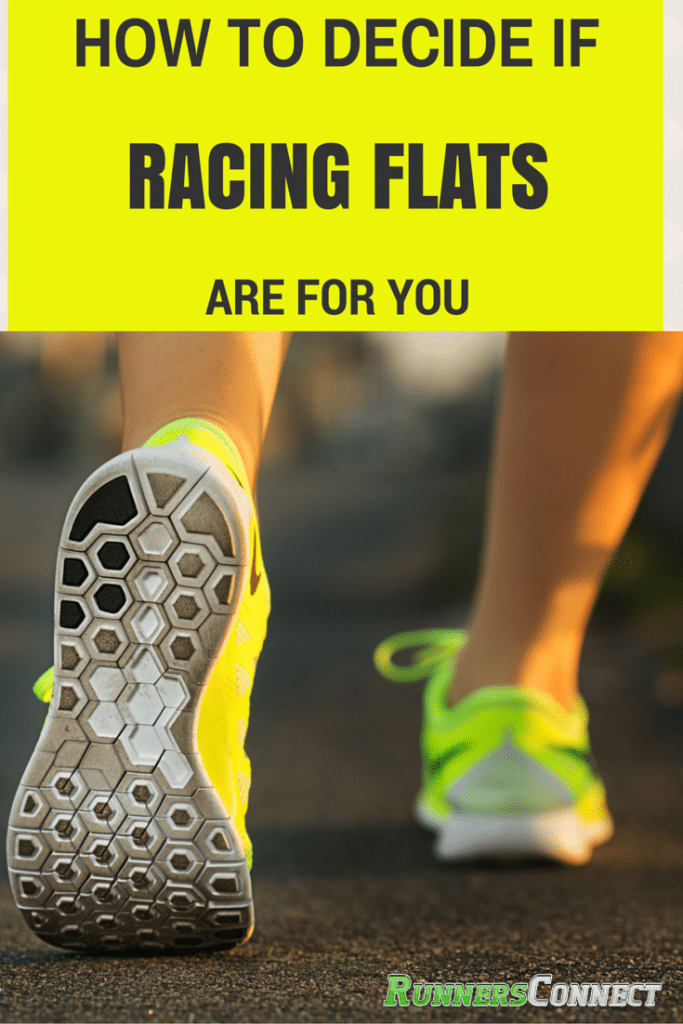
When you’re vying for a top ten finish at a major marathon or your most recent results determine if you can put food on the table, it’s easy to understand why wearing racing flats is a no-brainer. But can wearing racing flats help you, even if you’re not running world class times? Absolutely, and we’ll show you how.
First, we’re going to breakdown the scientific advantages and disadvantages of wearing racing flats. Then, we’ll give you specific instructions on when and what type of racing flat to wear no matter your pace or race distance.
Scientifically proven benefits of racing flats
Bill Bowerman and Nike became famous thanks to the introduction of the lightweight waffle racer. And since the day Bowerman first molded rubber with his wife’s waffle maker, scientists have been studying how racing flats can make runners faster.
Racing Flats improve efficiency
It doesn’t take a PhD to understand that the less weight your foot has to lift with each stride, the easier it is to turnover and move forward. However, few runners know exactly how this drop in weight will translate into their race times.
Luckily, a group of researchers determined that the effect of carrying extra weight on oxygen uptake is 1% per 100g per foot. Simply speaking, you can improve your VO2max by 1-2% for each 3-4oz you’re able to cut from your shoes. That’s a pretty quick and easy way to improve without any extra work.
Shorter ground contact times
Another benefit to the use of flats is improved ground contact time (the amount of time it takes your foot to hit the ground, roll forward, and toe off). Faster ground contact times lead to increased speed and efficiency, but only if a runner doesn’t have to generate greater force to improve contact time (i.e. it comes effortlessly).
By naturally improving your ground contact time without a related increase in oxygen consumption, flats help you run faster and more efficiently. Furthermore, faster ground contact times indicate mid-foot and forefoot foot strikes, which are indicators of proper running form.
The psychological advantage
While I really shouldn’t classify psychological advantages under the scientifically proven benefits heading, it is widely known that your mental preparation and outlook can have a major affect on your performance.
If you’ve ever slipped on a pair of 5oz racers just before the gun went off, you know how much of a mental boost it can be.
Sometimes just having your shoes feel as light as feathers can give you all the confidence you need. Likewise, an important component of racing is getting “in the zone”.
Any ritual you can perform on race day that helps trigger your mind into competition mode will improve your performance and execution. Slipping on the special racing shoes is a clear sign to your mind that it’s time to boogie. Remember, not all the benefits of racing flats have to be measured in a laboratory.
Scientifically proven disadvantages
While analyzing the potential benefits of racing flats may make using them seem like a no-brainer, strapping on lightweight shoes does have its drawbacks.
Increased injury risk
Without the abundant cushioning and support found in traditional shoes, racing flats increase peak pressure, maximum force, and contact area, which can result in higher occurrence of stress fractures and other stress related injuries.
Because training consistently and staying injury-free is the most important component to improving long-term, it’s important to think carefully about whether you’re ready to race in flats.
Increased recovery time after race
A related potential disadvantage of racing flats is that the increased stress and peak forces require a longer recovery cycle. Even if you emerge from the race injury-free, racing in flats could mean it takes longer for your muscles to heal.
This can be a perilous side-effect, especially if you’re already prone to over training or over racing. If it’s your last race of a training segment, you can be more aggressive with choosing to use flats since you’ll be taking some scheduled down time after the race anyway.
Considerations and whether or not you should wear racing flats
Like almost any aspect of training, the decision on whether to wear racing flats isn’t a one-size-fits-all solution. However, there are some general principles that can apply, from which I’ve derived a pretty accurate formula to help you determine if racing flats are the right footwear choice for you on race day.
1. Make sure you’re healthy
The first consideration is to make sure you don’t have any nagging injuries or tweaks that might flare up. If you’re already training gingerly to keep injuries at bay, racing hard in racing flats might be the straw that breaks the camels back.
2. Make sure you adapt by training in flats first
The rule with almost any race, especially the marathon, is never try something new in race. The same principle applies with flats. If you’re going to test them out, make sure you take the time to run a few of your workouts in them first. It’s much easier to stop during a two-mile interval if your calves get sore than to have to walk the last 4 miles of a half marathon.
Time and pace recommendations
Unless injury or biomechanical weaknesses preclude you, here is a chart to help you determine if flats are a good choice for you:
| Men | Women | Recommendation | |
| 5k ability | Sub 18 minutes | Sub 20 minutes | Definitely should be wearing flats at all races for optimal performance |
| 18 – 21 minutes | 20 – 22 minutes | Wear flats during important races or lightweight trainer | |
| 21 – 24 minutes | 22 – 25 minutes | Flats if they feel comfortable but performance benefit will be minimal | |
| Over 24 minutes | Over 25 minutes | There is little benefit to wearing racing flats |
This chart is derived by comparing potential time benefits with increased risk of injury.
4. Heavier the longer the distance
Finally, choosing the right flat for you is also based on your race distance. In general, the shorter the race, the lighter, less supportive, and less substantial your shoe can be.
- For a 5k or 10k race, a shoe weighing in the 5-6oz range is optimal.
- For races from 12k to the half marathon, you should find a shoe that is 7-9oz.
- For the marathon, a shoe that is 7-10oz is optimal, unless you’re a sub 2:40 marathoner.
If you fall into one of the above ranges and you’re training hard and just need to lose that last 5-10 minutes to hit your goal or qualify for Boston, give racing flats a try and see how much they can improve your performance on race day. Of course, we’re always available to answer questions about flats in the forums section. You can ask the coaches whether are right for you and solicit the best makes and models from your teammates.
A version of this post originally appeared at competitor.com





3 Responses
Can someone with high & rigid arches wear a racing flat? I have always feared not having enough impact protection from a shoe with less cushioning so I always stuck with trainers.
What size shoes are those ideal weights in ounces relevant to? i.e. men’s size 10? I figure the bigger the shoe size the heavier the shoe will be…
Great question. The weight for shoes are usually based of Men’s 9 and Women’s 8 sizing. Indeed, the bigger the shoe, the heavier the weight.
In this article, the weight is really a measurement of the type or amount of the support in the shoe. The lighter the weight, the less the support. The support is actually how I determine what type of shoe is best for each distance. Meaning, a 5oz shoe has very little support (even if the real weight is 7oz for someone with a big foot) because of the design.
So, while the weight might be different for your size, the recommendations for the company’s shoe weight and race distance remain the same.
Hope that made sense.